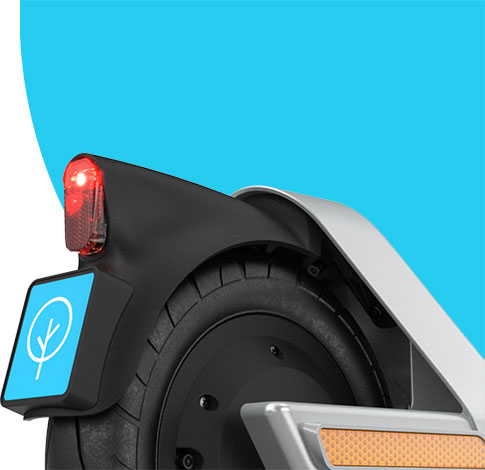Of the many, many things that differentiate ride-hailing operators like Uber from micromobility operators like Bird, life cycle assessments may be the most surprising.
To review, a Life Cycle Assessment (or LCA) is a sort of methodology for determining the environmental impact of a given product or service. In April, for example, Bird released an LCA of our Bird Two electric scooter in San Francisco, demonstrating that, from manufacturing to recycling at the end of its usable life, a Bird Two emits around 97.2 grams of CO2 equivalent per passenger mile (gCO2e/pmt). Ride hailing vehicles, on the other hand, emit anywhere from 550-750 gCO2/pmt.
But that’s not the surprising bit.
What’s surprising is that, while many cities require micromobility operators to perform these detailed and expensive analyses in order to obtain an operating permit, ride hailing companies are exempt from this practice. To this day we’re still not entirely sure why that is.
Rather than debate the reasoning, however, it’s more important to share with you some of the things we’ve learned along the way. Bird has been operating shared electric scooters longer than any other company on Earth, so we take both our experience and our responsibility to the environment seriously.
In order to understand how to accurately assess the environmental impact of an electric scooter, it’s important to know what calculations and assumptions go into the process. So here are some of the most critical things to keep in mind.
Research and Development
This is admittedly a step to consider prior to performing a life cycle assessment, but it bears mentioning nonetheless. After all, if you’re going to expend the time and resources necessary to perform an LCA, you’ll want to be sure your product is worth analyzing in the first place.
Bird has made it a point to invest heavily in research and development, extending our fleet lifespan by 400% in just two years. The Bird Two became the industry’s most sustainable scooter precisely because our unrivaled vehicle and design teams used advanced aerospace and automotive engineering to increase its projected lifespan beyond 24 months—and we’re just getting started.
Of course, the nascency of the micromobiltiy industry and the speed at which e-scooter technology is advancing raises an interesting question: what happens if, by the time an LCA is complete, the industry has already moved on?
Lifespan Assumptions
Methodology and assumptions can vary dramatically between operators. For example, to ensure accuracy and objectivity during our first LCA, Bird enlisted the help of CEA Consulting and an independent consultant from the National Renewable Energy Laboratory. It’s important to consider these factors when comparing competing claims on scooter emissions and sustainability.
Among the most important assumptions made during an LCA is the projected lifespan of a vehicle. That’s because a majority of the emissions attributed to an e-scooter come from the manufacturing process itself. These initial emissions then are amortized over the lifespan of the vehicle, meaning the more miles traveled, the lower the per-mile emissions.
While that calculation may seem simple enough, a scooter’s lifespan can vary across cities depending on myriad factors such as road conditions, weather, topography, vandalism and theft. Due to Bird’s industry-leading experience, continued innovation and the fact that tens of thousands of our Bird Zero vehicles are still on the road since their launch in early 2019, we’re confident in our ability to understand the factors determining vehicle lifespan.
Recycling, Credits and Carbon Offset Assumptions
While it’s clear that shared micromobility lowers CO2 emissions with respect to cars, many additional steps can and should still be taken to mitigate the overall carbon emissions of our industry. At Bird, we recycle our vehicles at the end of their usable life, in addition to purchasing energy attribution credits and carbon offsets. These initiatives are not included in our LCA estimates referenced above, however. We do this to err on the side of caution, and to ensure we’re not greenwashing our carbon footprint in any way.
Recycling is incredibly important to overall vehicle sustainability, which is why we work with cutting-edge experts to increase the recycling rates for each part of our electric scooters. In France, our partnership with a leading environmental compliance organization achieves indicative recycling rates above 95% for ferrous and non-ferrous materials and 86% for e-waste components.
City Support and Protected Infrastructure
Interestingly, operators are not alone in bearing the responsibility for electric scooter sustainability. Investments in protected bike and scooter infrastructure, as well as reclaiming public space from private automobiles, makes micromobility more attractive to an increasing number of city residents. This in turn raises the rates of utilization of shared micromobility, which further drives down emissions per passenger mile. We see this in an increasing number of cities, most notably in Paris, where robust efforts by Mayor Anne Hidalgo to increase bike lanes have led to record growth in micromobility use.
The network effect of a well-utilized fleet improves with the density of available vehicles, adding to the fleet’s overall sustainability. Thus, perhaps the most effective way for policy makers to realize lower emissions is to turn away from car-centric cities and make alternative modes of transportation more attractive through the reallocation of space.

